I designed Solbein Cardigan to be an ethereal light weight garment using a larger needle than is called for on the ball band. Lettlopi is an aran weight yarn and I used a needle size you’d more commonly use with a bulky weight yarn.
Sólbein is knit top down and in the round, with two purled steek stitches down the front which are later cut open to make it a cardigan. This is a pretty common way of making steek stitches in Iceland, often they only have a single purled stitch. The column of knit stitches on the reverse side make it easy to see where to run a line of sewing machine stitching to reinforce them. My Sólbein Cardigan pattern comes with an illustrated tutorial for the machine sewn process.
Now I know it isn’t always easy to carry a sewing machine around in your knitting bag, but a crochet hook fits just fine. Guess what? You can reinforce your steek stitches with slip stitch crochet! The thing is, it’s a little tricky with the purl-stitch steek to see what you’re doing. It may be wise to plan ahead if you know you don’t want to use a sewing machine and make a different kind of steek.
I made a couple of swatches, practicing for color and I decided to make some steek stitches in them so I could quickly show how to do a crocheted steek with the two purled stitches as the pattern is written, and another version with 3 stockinette stitches for the steek.
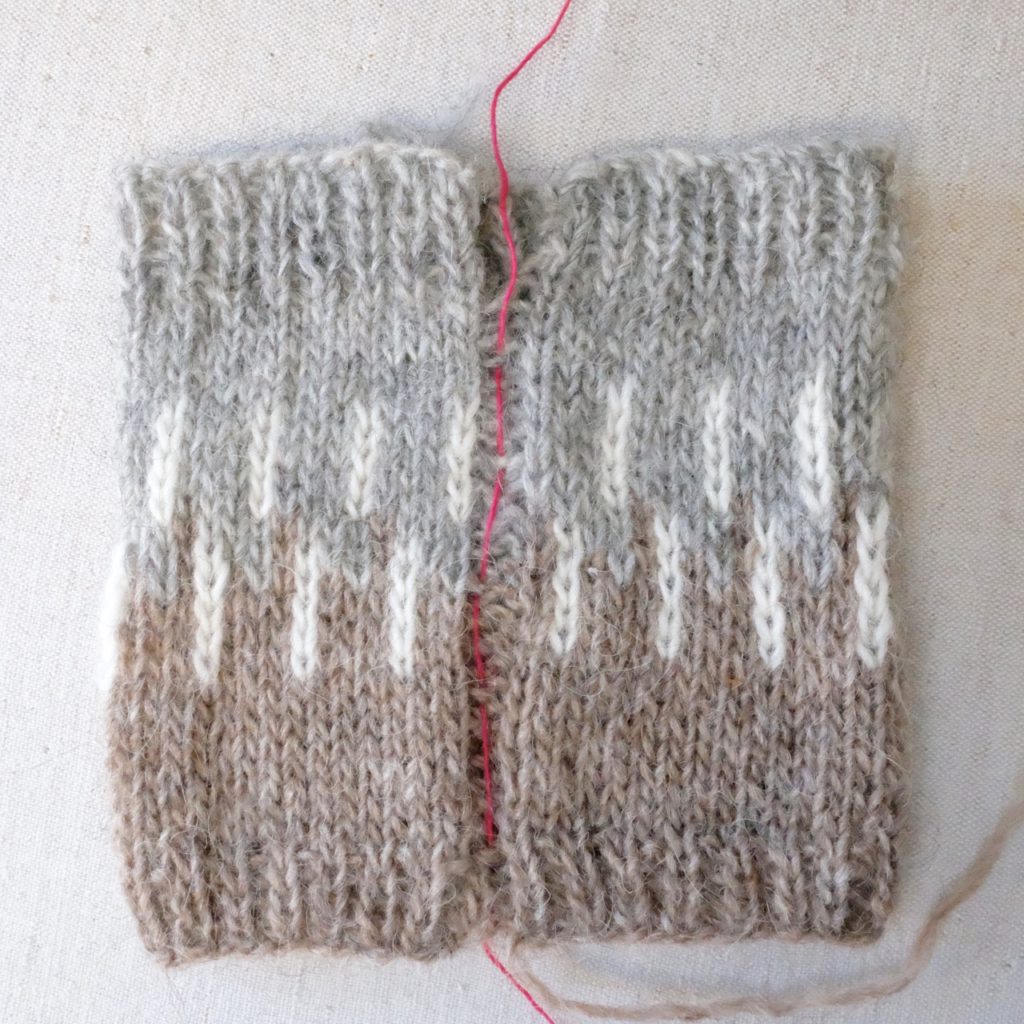
A pink basting thread marks the center of the two purl-stitch steek.
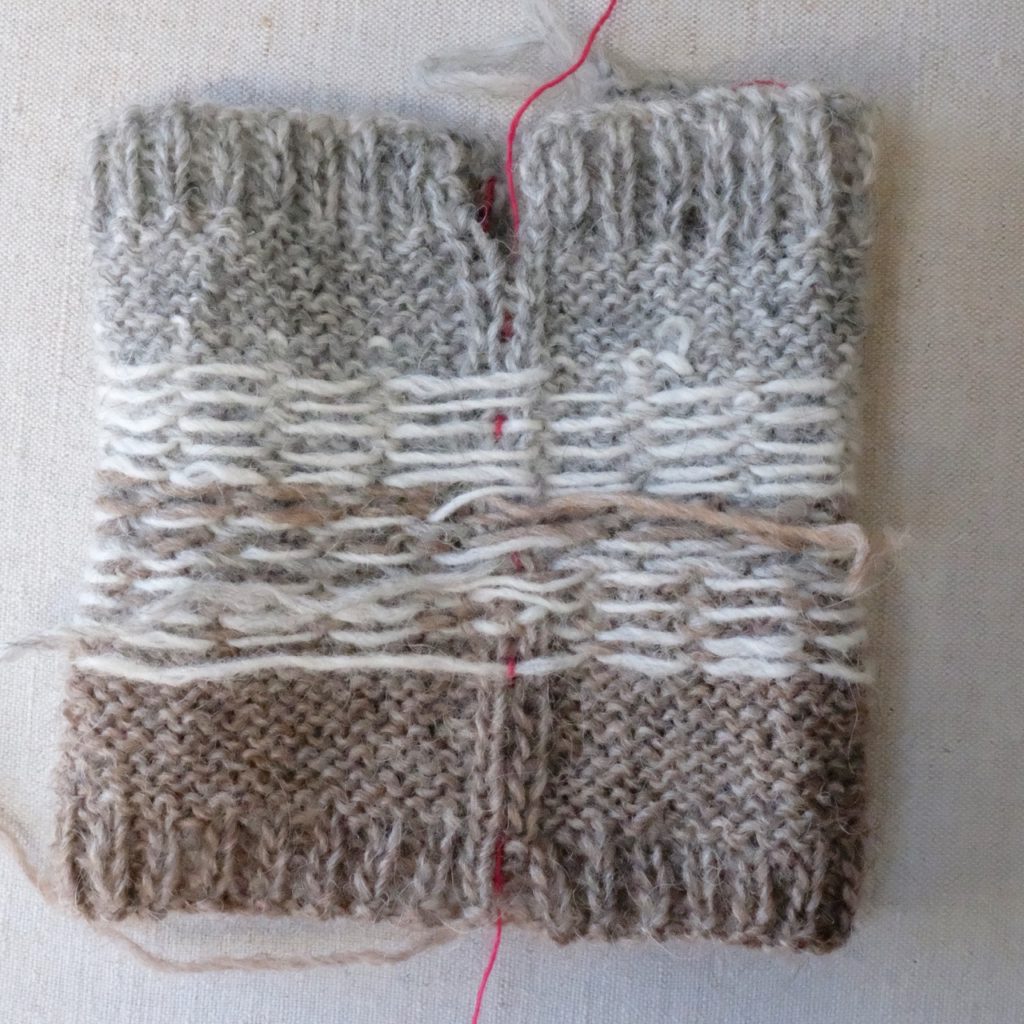
In real life, you can see the steek stitches underneath the floats that obscure them. If you were using a sewing machine to reinforce the steeks you would work from this side. The sewing machine will nail down the floats and the steek stitches.
Plan ahead If you know you’d like to do crocheted reinforcement, you may want to make a 3 stitch or 5 stitch stockinette-stitch steek. You will want to alternate the colors used in the rows you are knitting. This will make it easier to work the crochet reinforcement because it is easy to see the individual stitches.
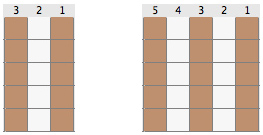
Sample stockinette stitch steek charts. The stitches of the three stitch steek will be cut down the center of stitch #2. The five stitch steek will be cut down the center of stitch #3.
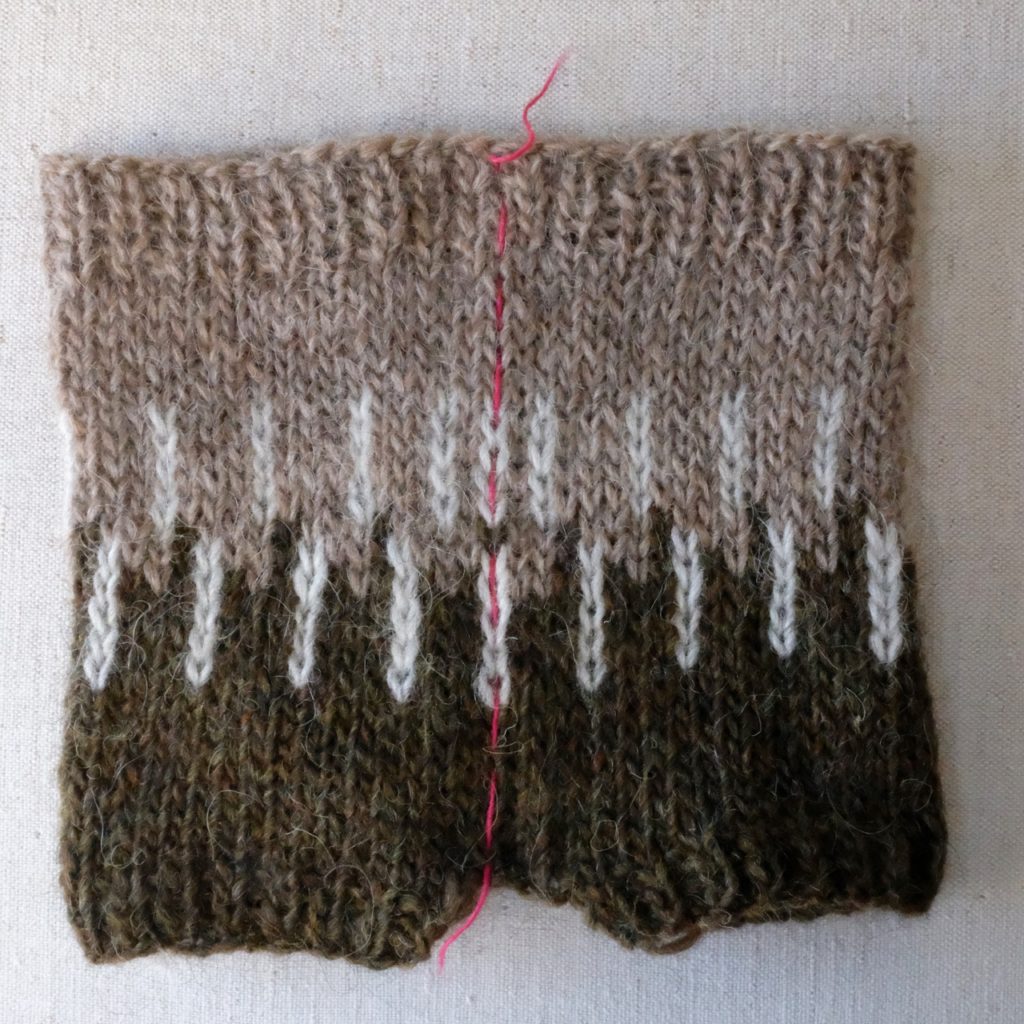
A pink basting thread picks out the center stitch of the steek. With crochet, you need to work from the right side of the work so the finished edge will magically fold to the inside once the button band is picked up.
Let’s get started!
First gather all your materials together. Make sure you are well rested and hydrated. Have an apple handy or a chocolate bar in case you get hungry.
You’ll need a pair of sharp scissors. A crochet hook slightly smaller in diameter than the Lettlopi. For the reinforcing yarn choose a color close to the body of your garment, just to make sure it won’t show through to the front. It should be a sticky yarn, not something like superwash. I used Jamieson & Smith 2 ply jumper weight. And for my demo I chose a color that would stand out not blend in so you can see it.
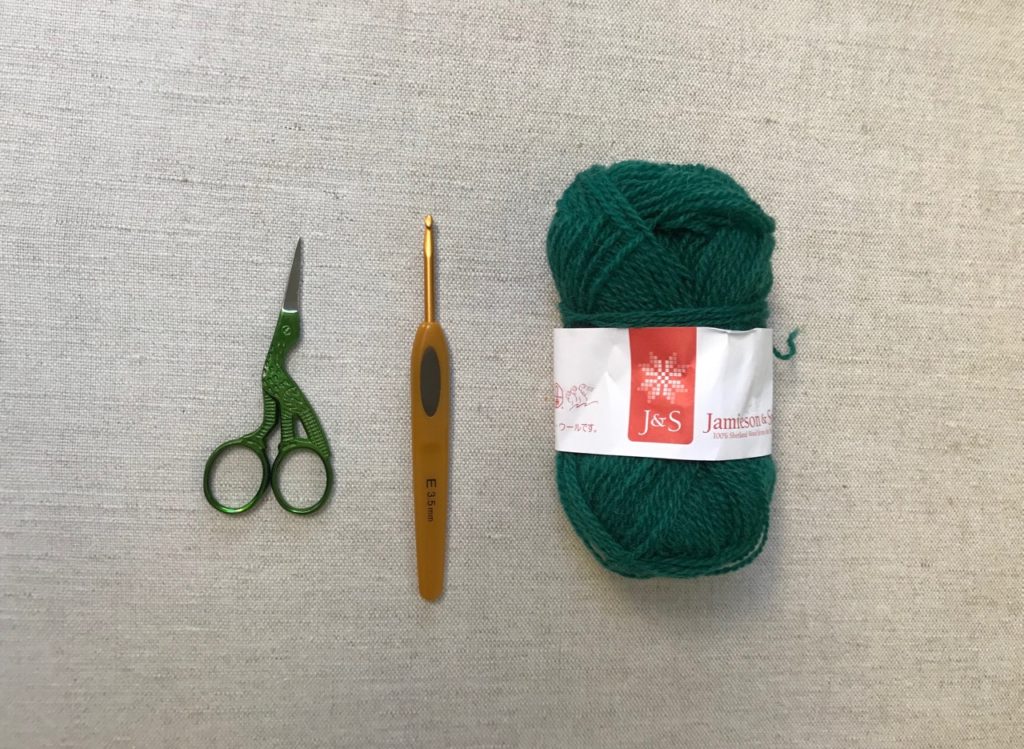
I also like to have a tapestry needle and a bright thread slightly longer than the length of the garment. I used it for basting down the center stitch as seen above, and where I will eventually cut. It also helps me when I’m picking up the stitches I’m going to crochet.
I’m going to show you the stockinette stitch steek first, because it is a lot easier to see.
Reinforcing Stockinette stitch steek with slip-stitch crochet
We work a line of slip stitch crochet as reinforcement. As you face the garment (or swatch) work from the bottom left side, moving to the left, up towards the neckline. When you get to the end of the steek, fasten off the yarn. Then rejoin new yarn and work down the right side of the steek.
Working the Slip-stitch crocheted reinforcement.
Left to right above: Working from bottom left, insert the hook in one leg one of the stitch adjacent to the center stitch and one leg of the center stitch. Pull reinforcing yarn through. Insert the hook through the next legs to the left of the ones just worked. Bottom row left to right: Pull the reinforcing yarn through new legs and the loop of the reinforcing yarn. Continue in this manner until you reach the end of the steek.
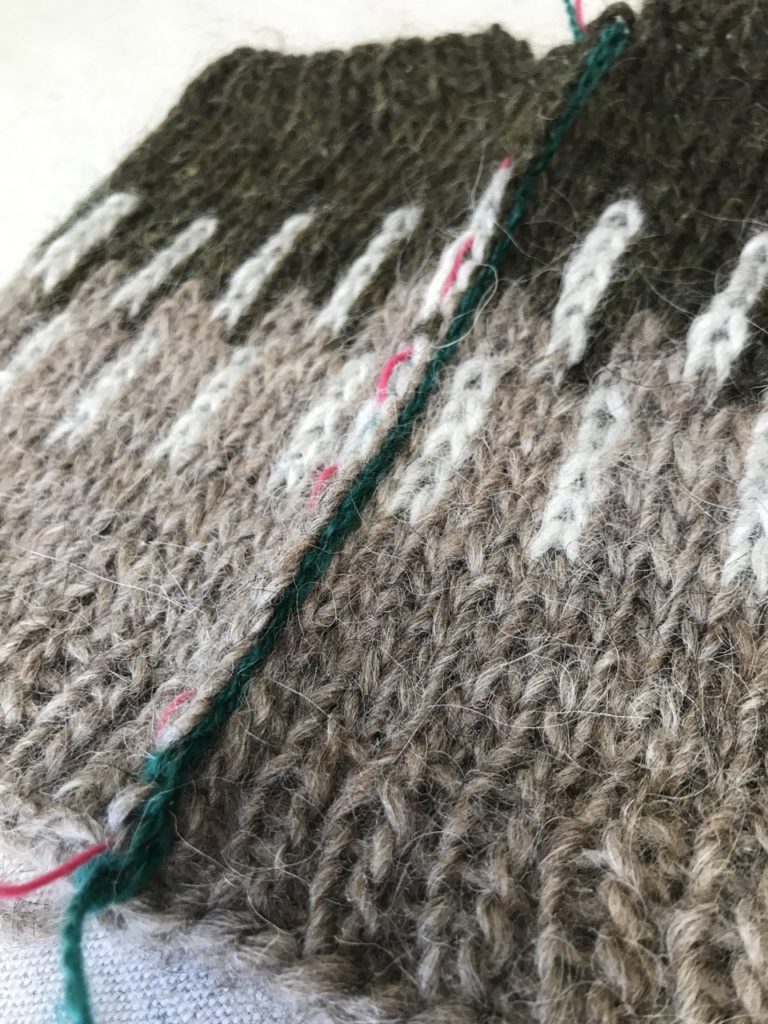
Left: Working second side of steek. Right: Both sides of steek reinforced.
Pull apart the reinforced stitches to reveal the bars between them which we will cut.
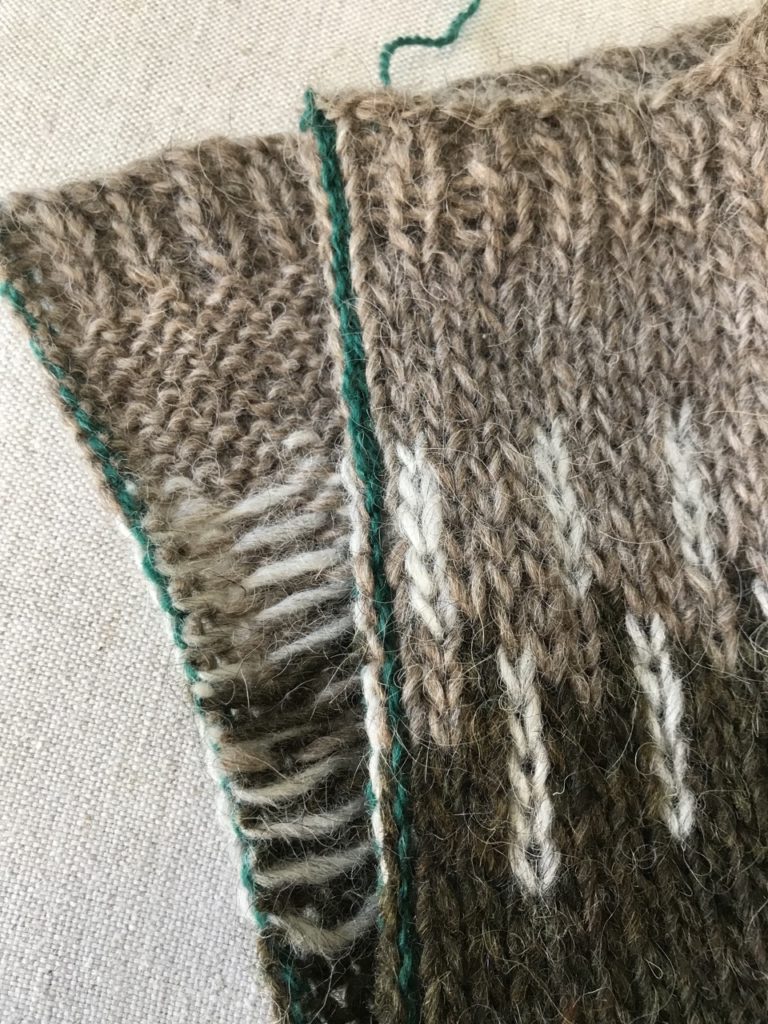
The act of picking up for the button band will further secure the floats.
I didn’t add button bands, maybe next week!
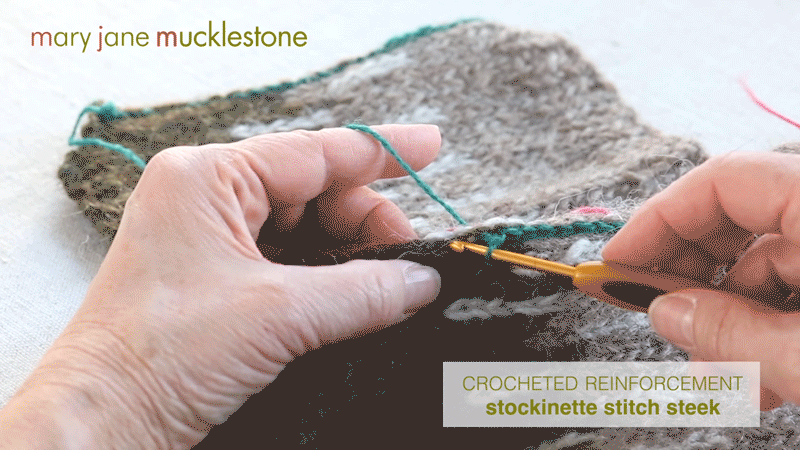
Crochet reinforcement for purl-stitch steek stitches
Now! Reinforcing the purl-stitch-steek with slip-stitch crochet. It is a bit hard to see the stitches you need to pick up. Just go slowly and analyze as you go, peeking to the inside if it helps. We will be crocheting one leg of the center purl stitch and the closest leg of the adjacent body stitch. This means we will be infringing on the body of the sweater, but it is only going to reduce the circumference of the sweater by one or two stitches depending on where you pick up for the button band.
The process is the same as the stockinette stitch steek, only it’s a lot harder to figure out which leg of the purl stitch you need to catch, but as I said, go slowly. And when you’re finished, celebrate!
It makes a pretty edge on the right side. On the wrong side the floats are floating free. They can be caught when you pick up for the button band as you can see below. Also remember, Lettlopi is sticky, so it is unlikely to unravel.
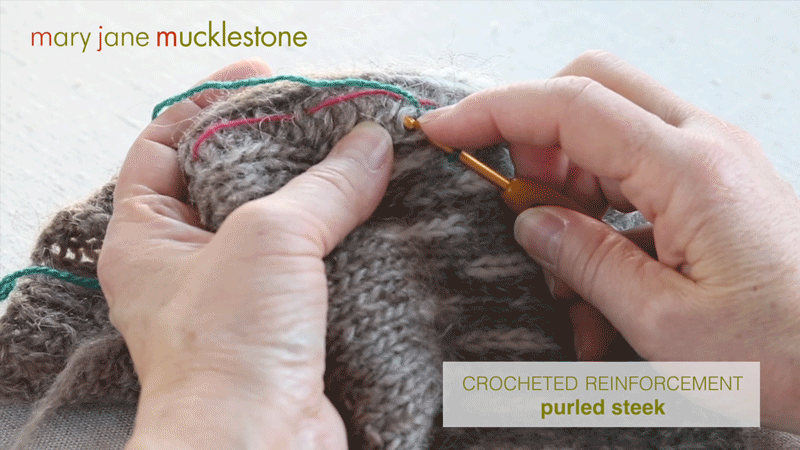
OK folks! That’s it for now! Hope to see you in January for the Fringe and Friends Steekalong! Tag your pictures #fringeandfriendssteekalong #sólbeincardigan #maryjanemucklestone so we can all find them and see them!
Sólbein Cardigan Images by Carrie Bostick Hoge. All other images are mine. Solbein Cardigan pattern can be found on Ravelry and also in Making Magazine No.4 Lines.
Many thanks to Emily Qualey for making the gif magic !
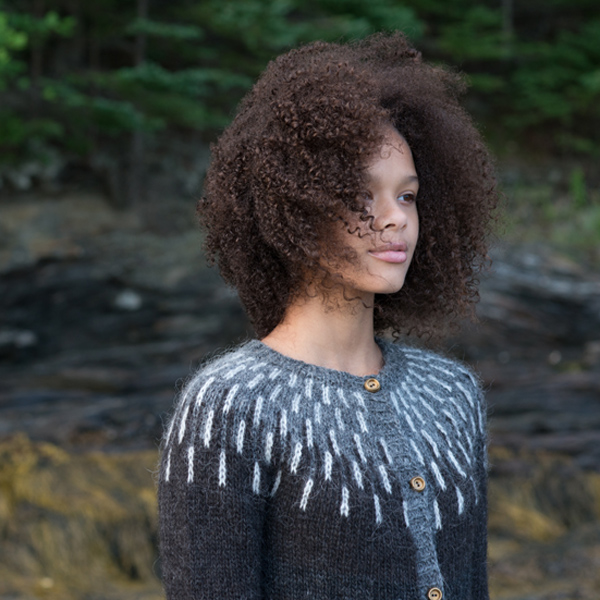
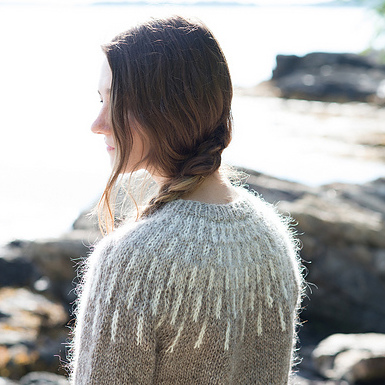
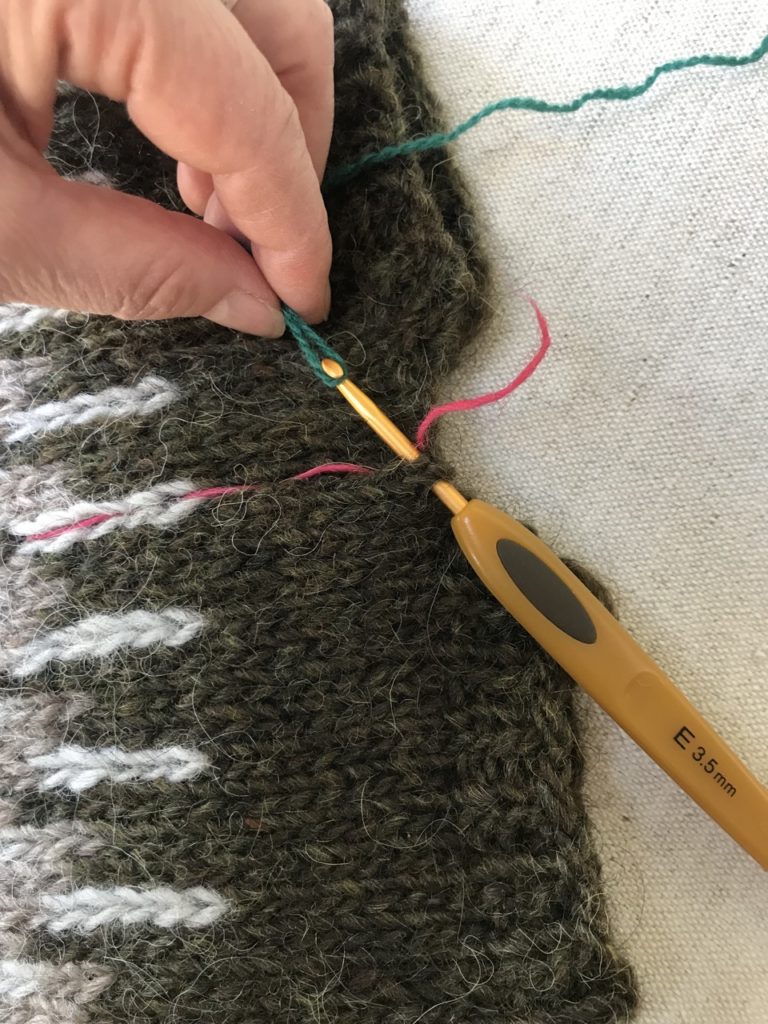
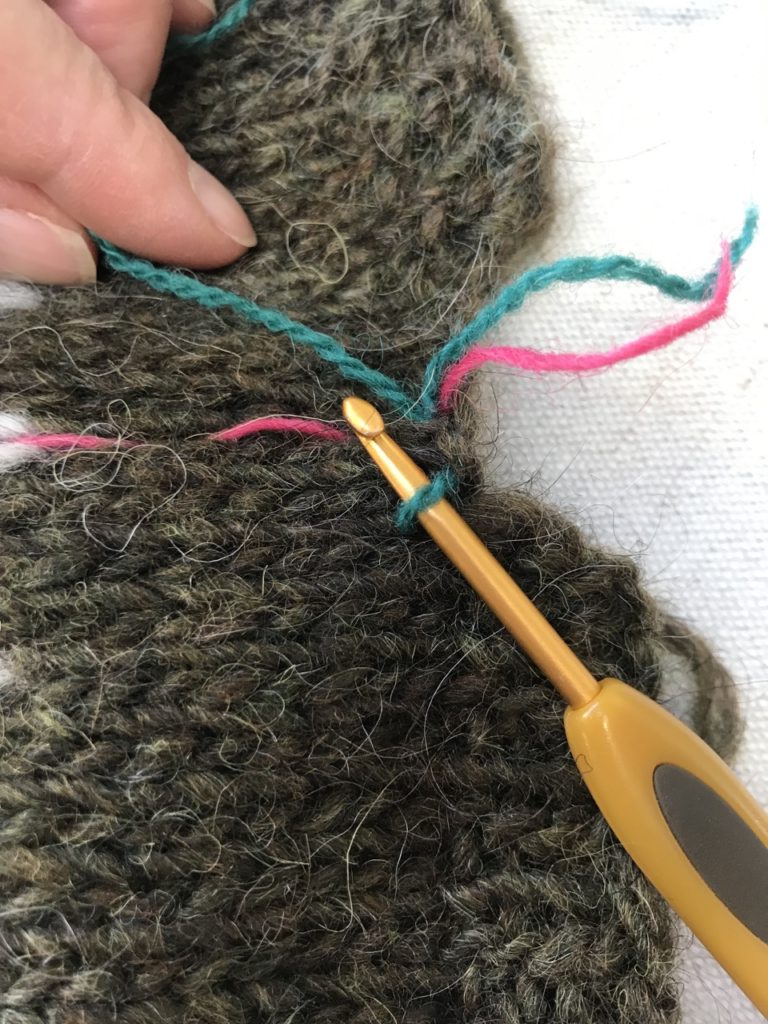
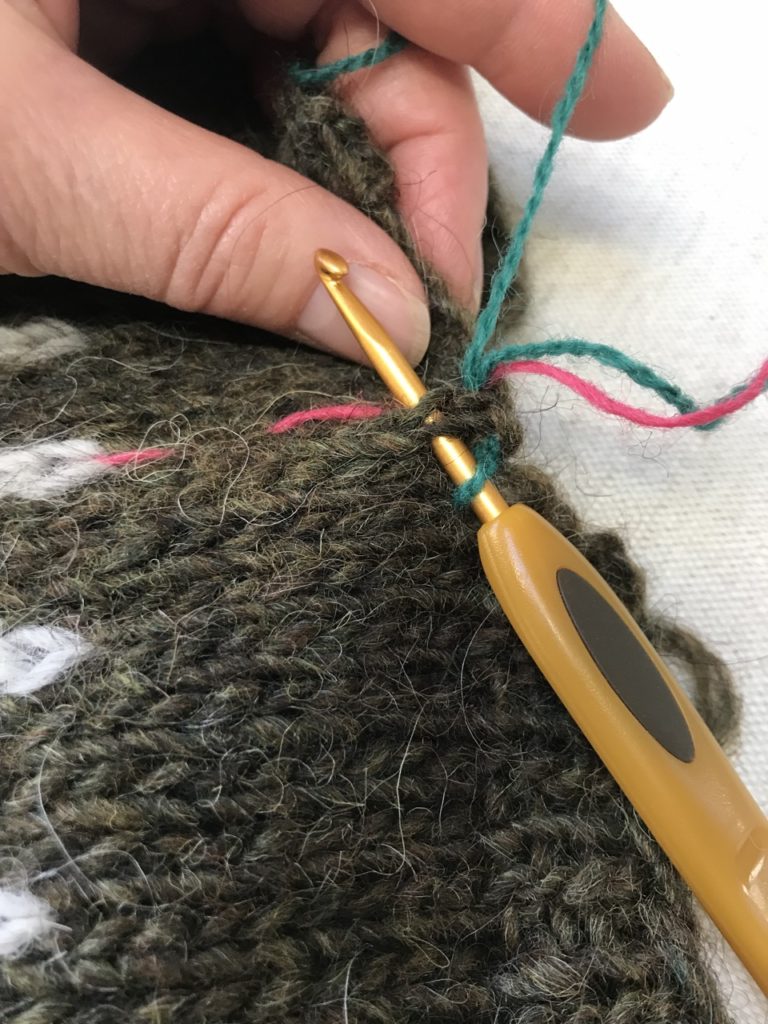
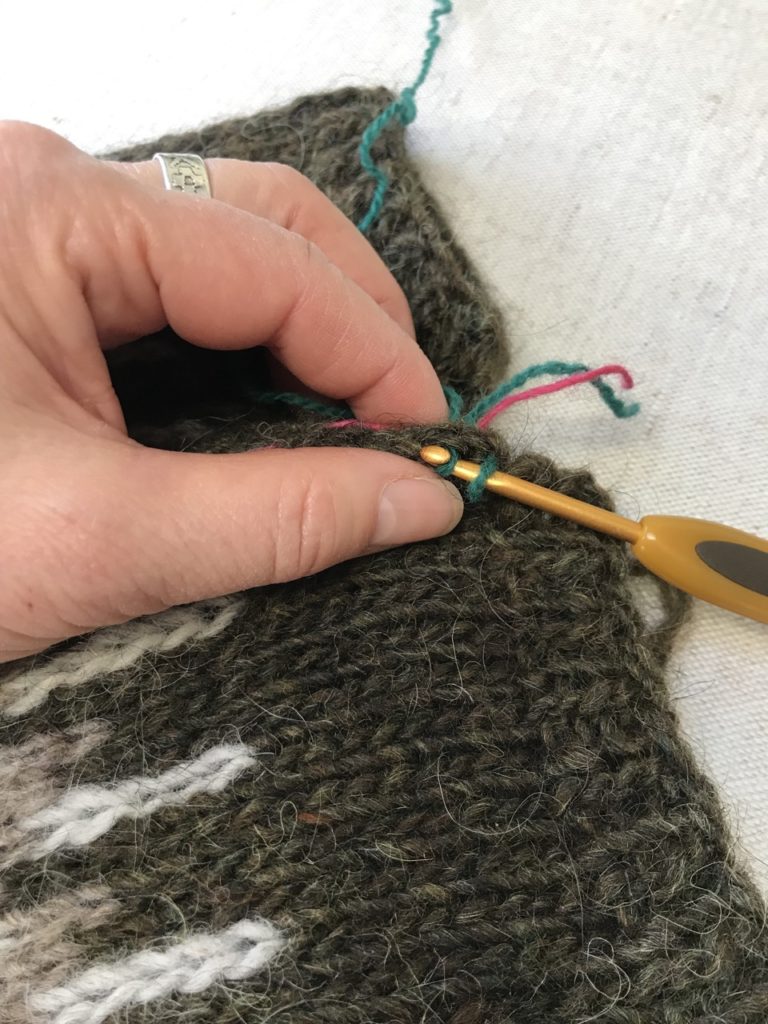
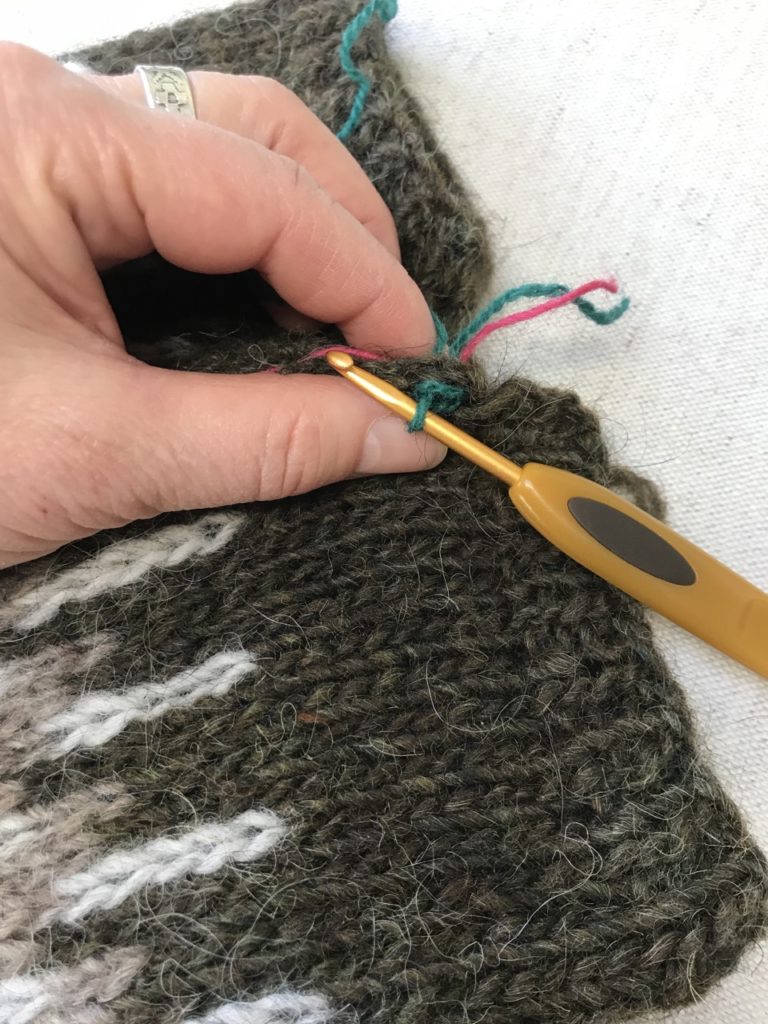
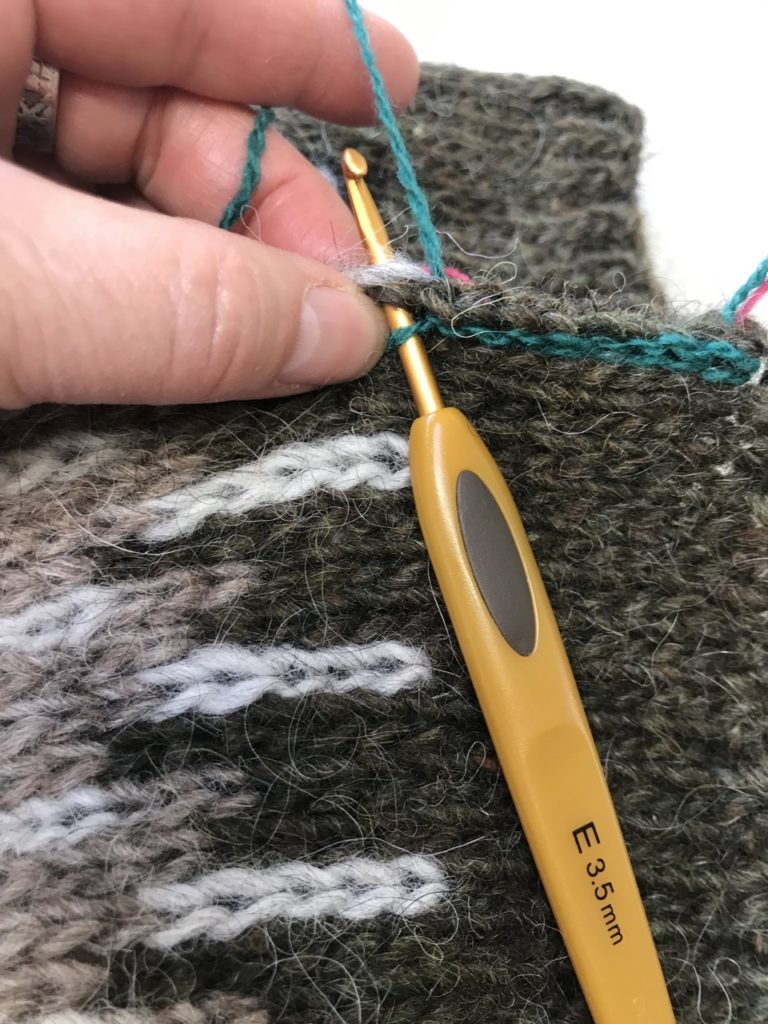
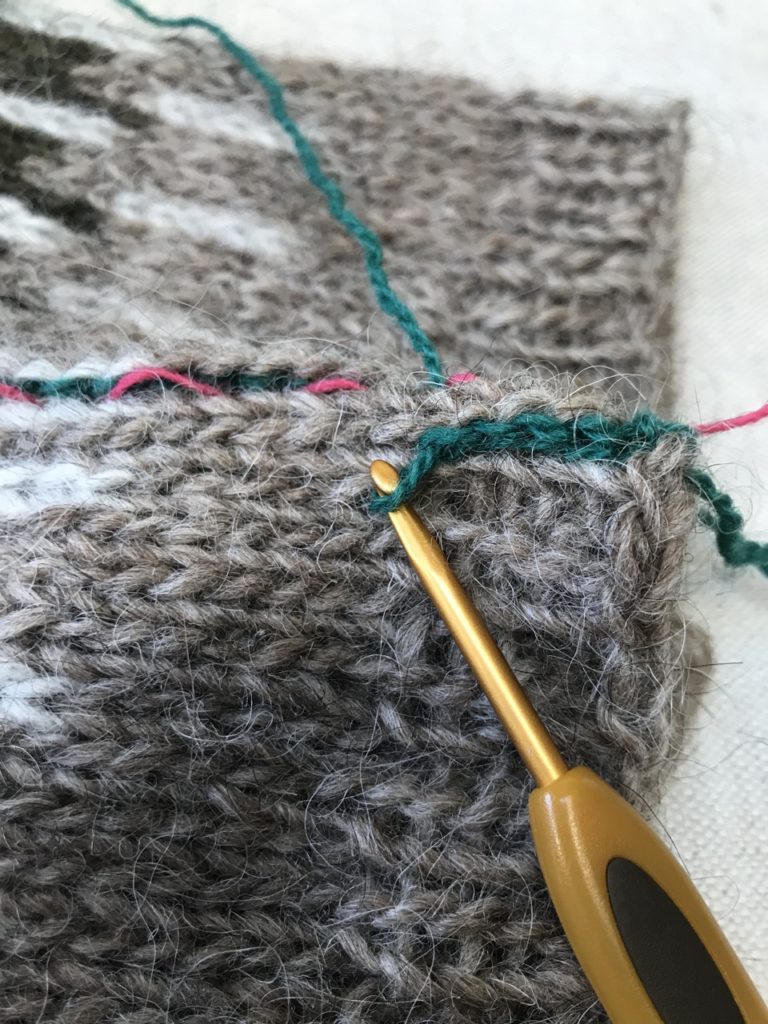
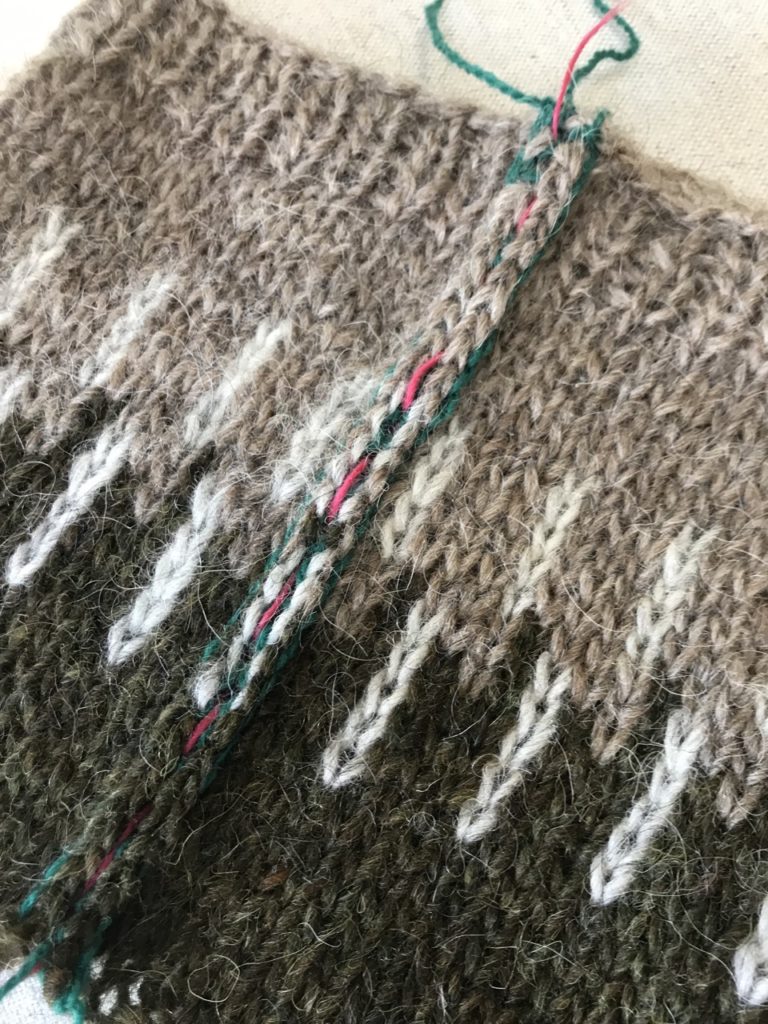

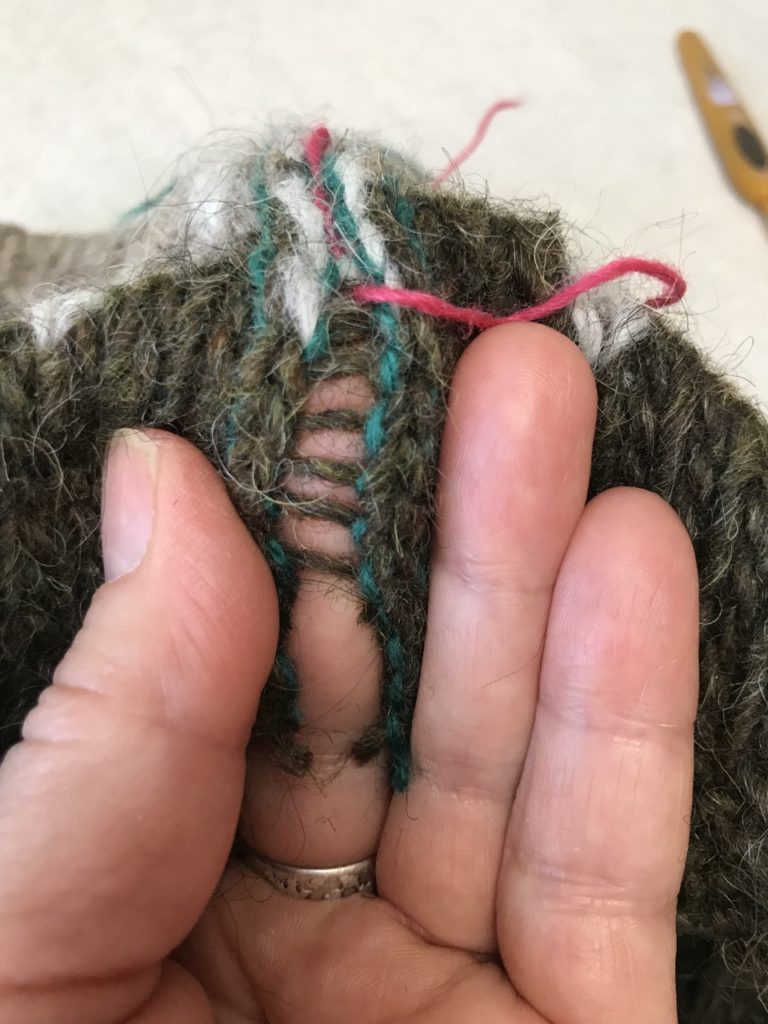
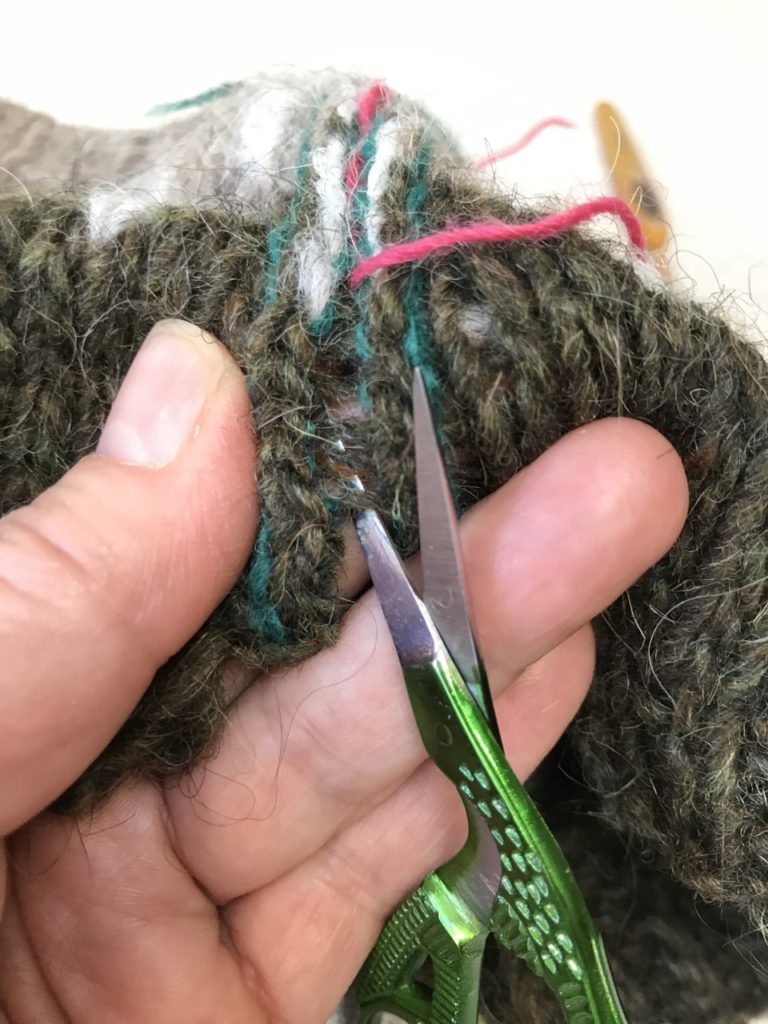
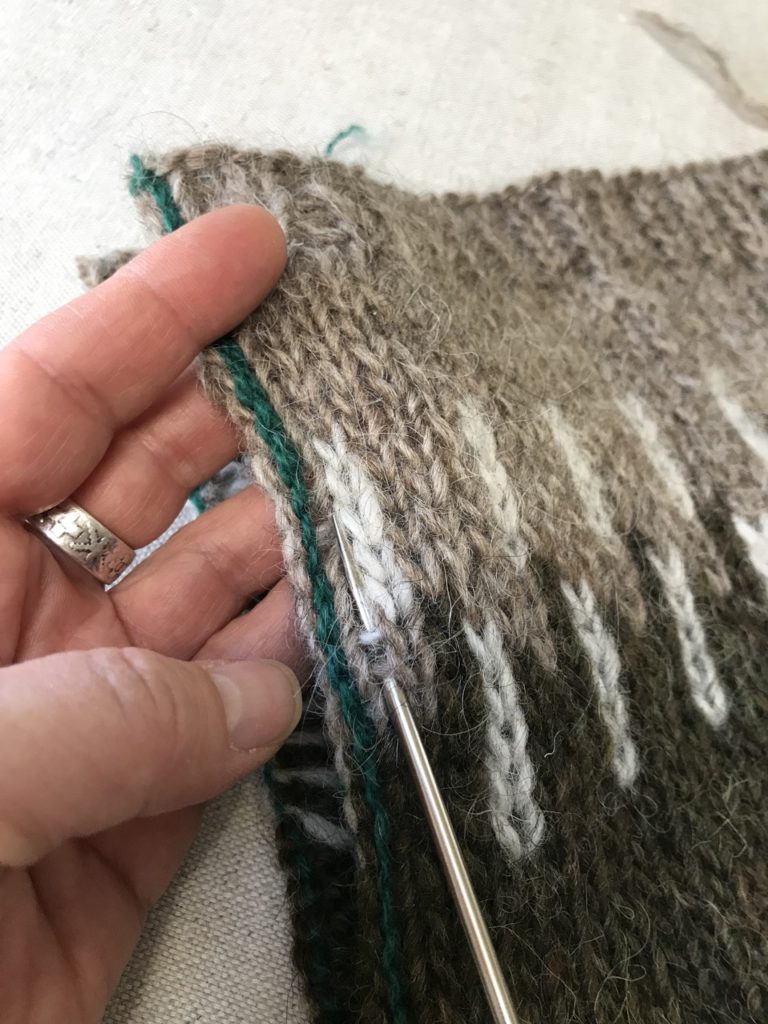
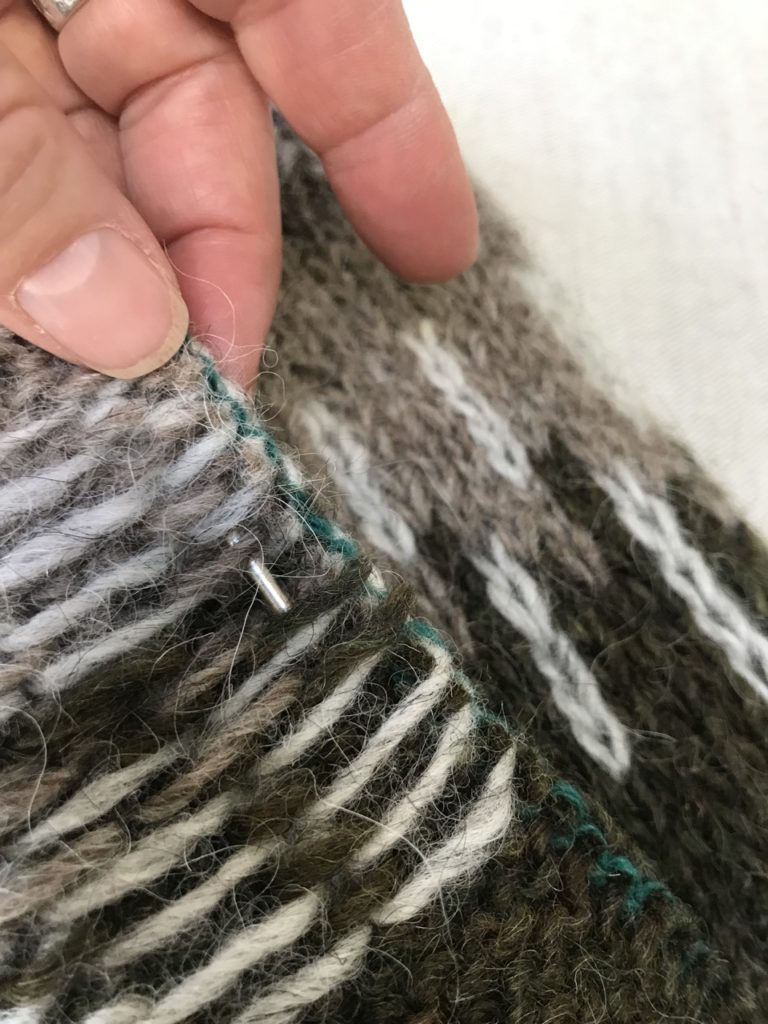
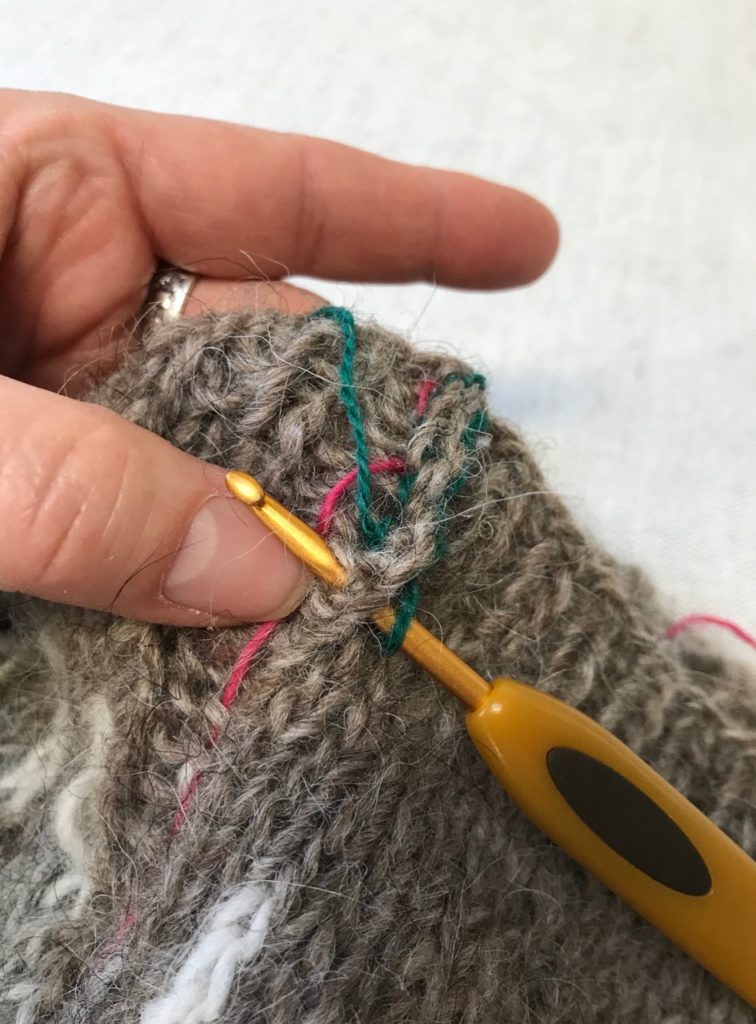
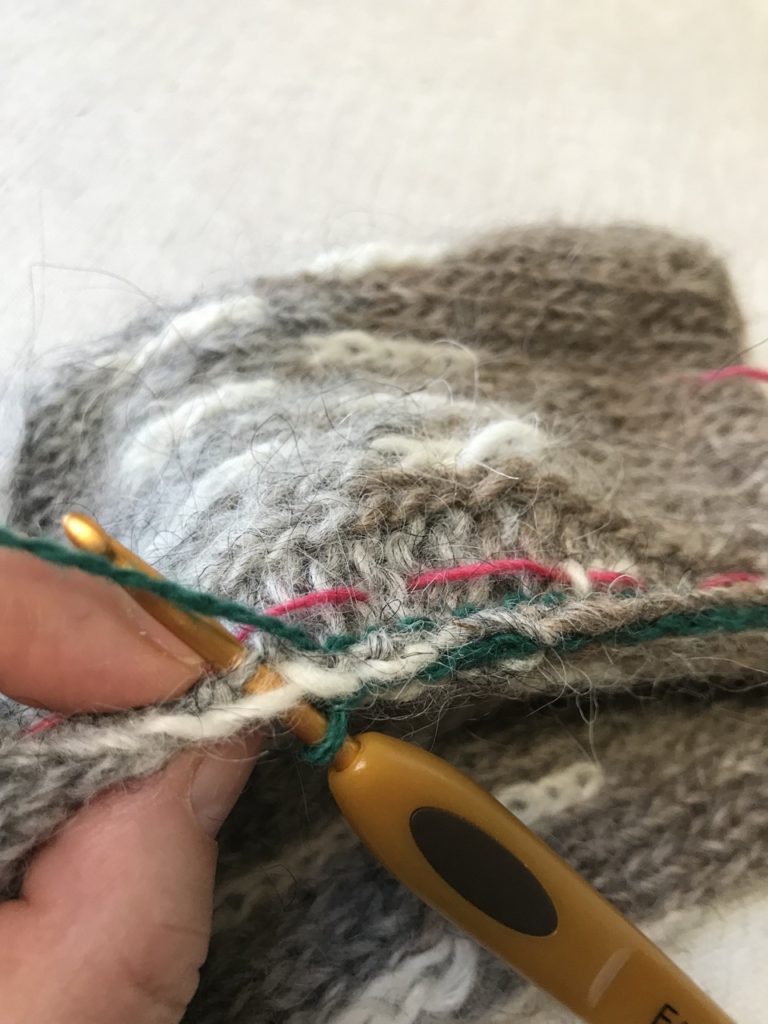
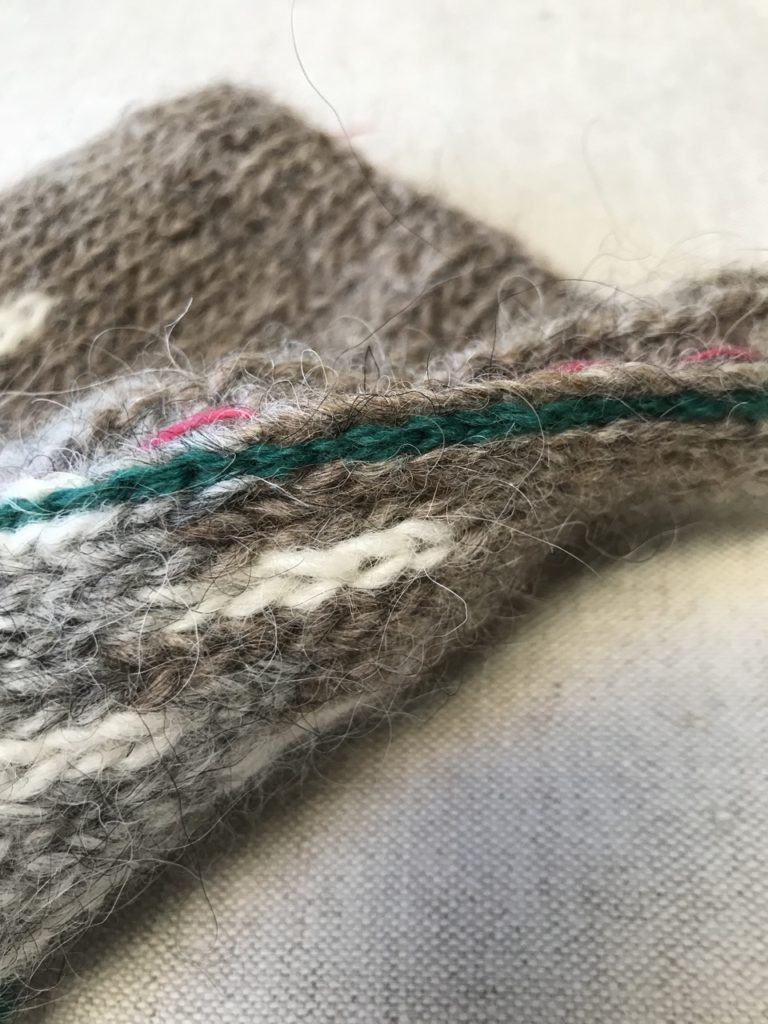
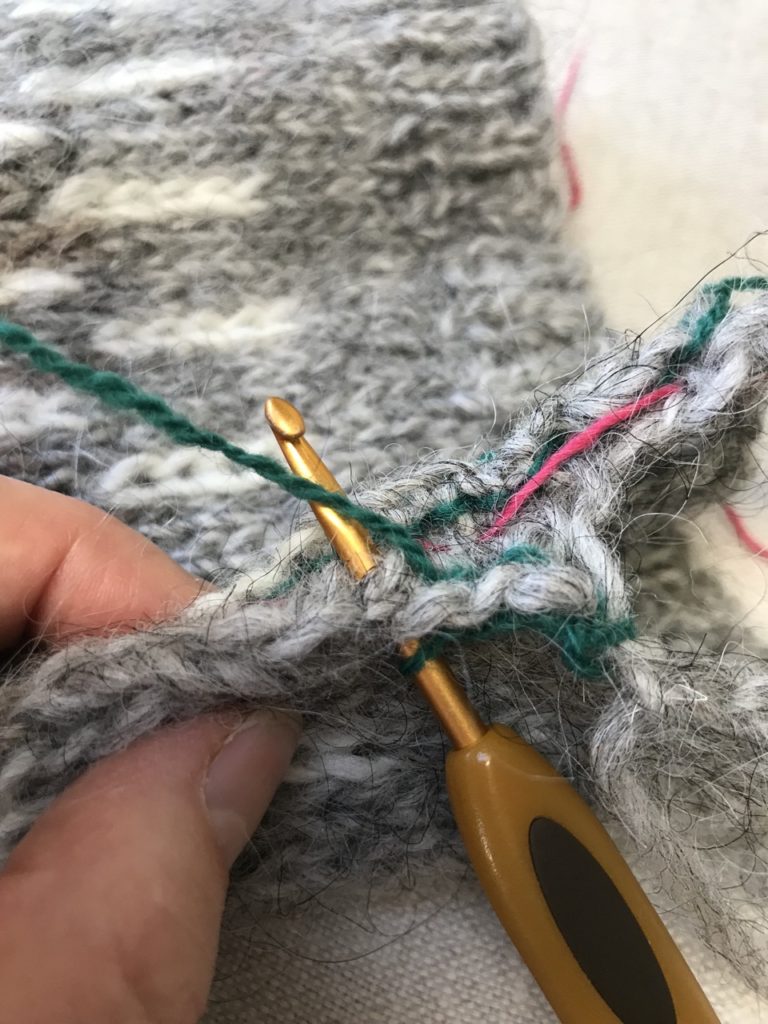
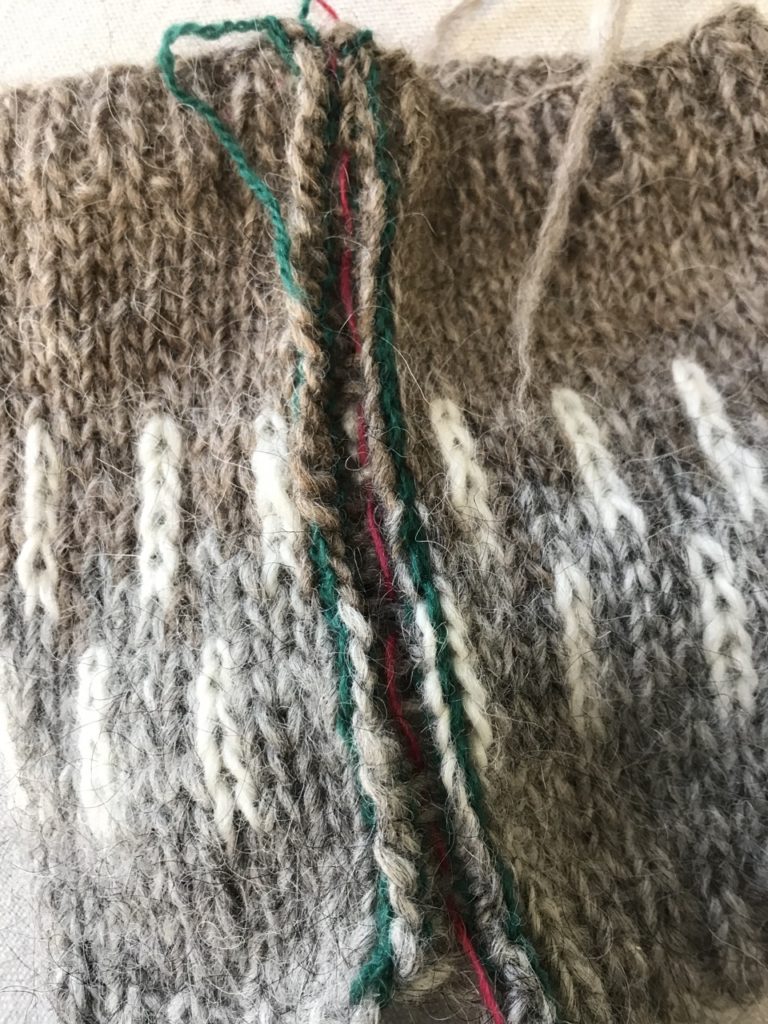
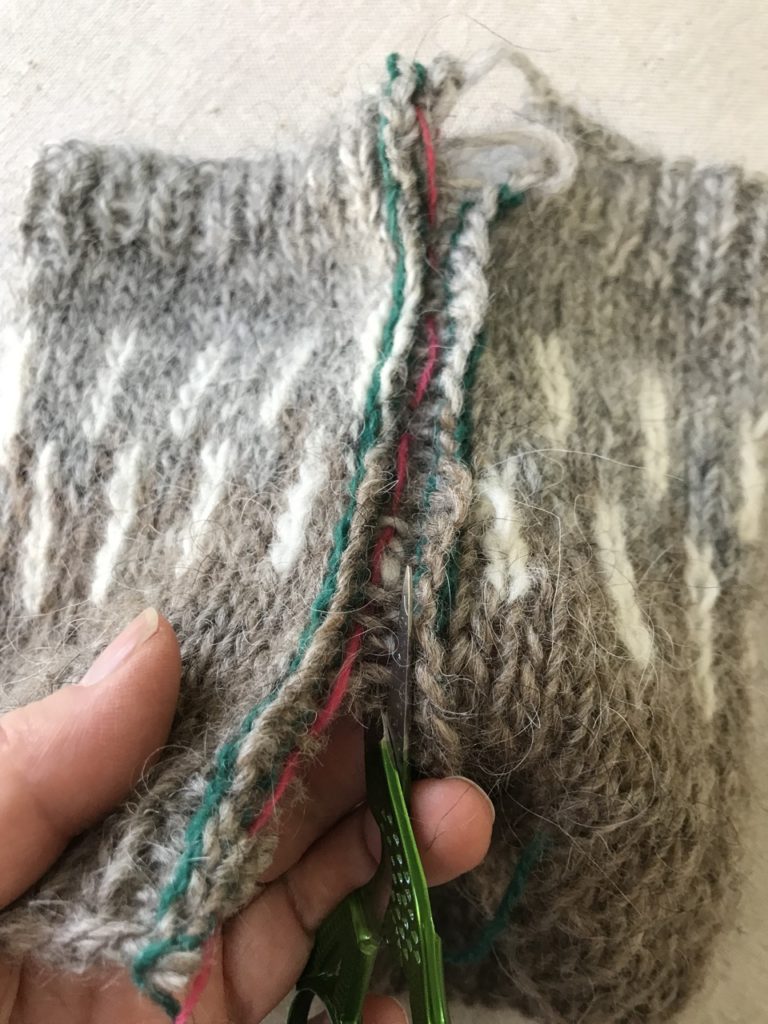
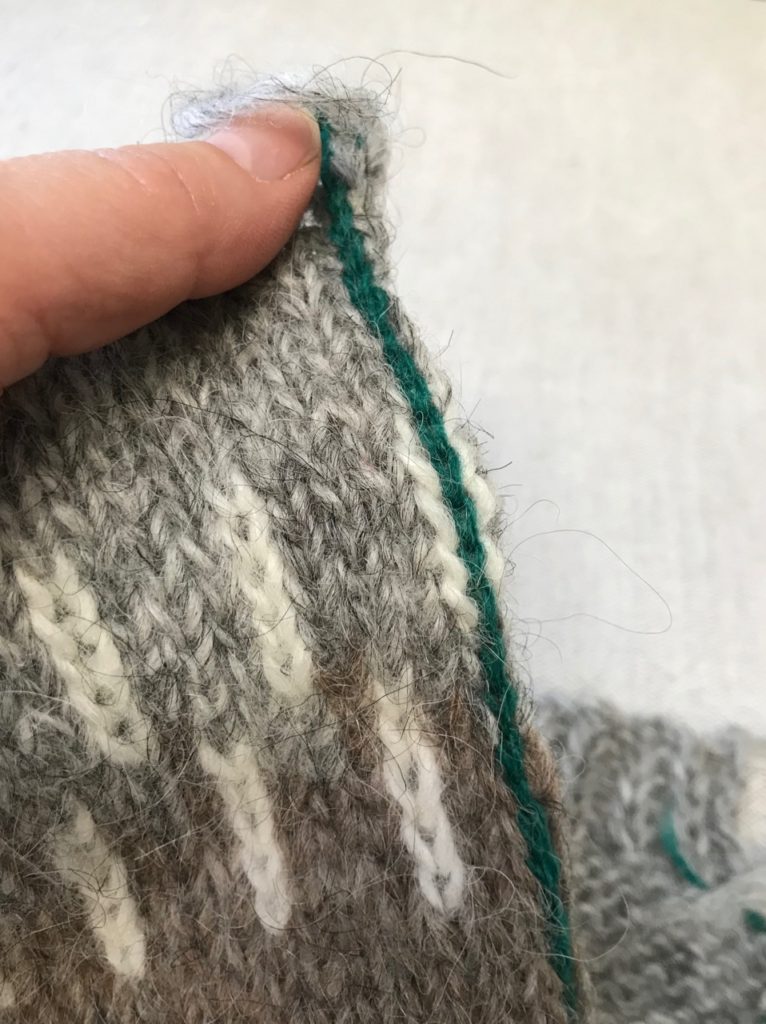
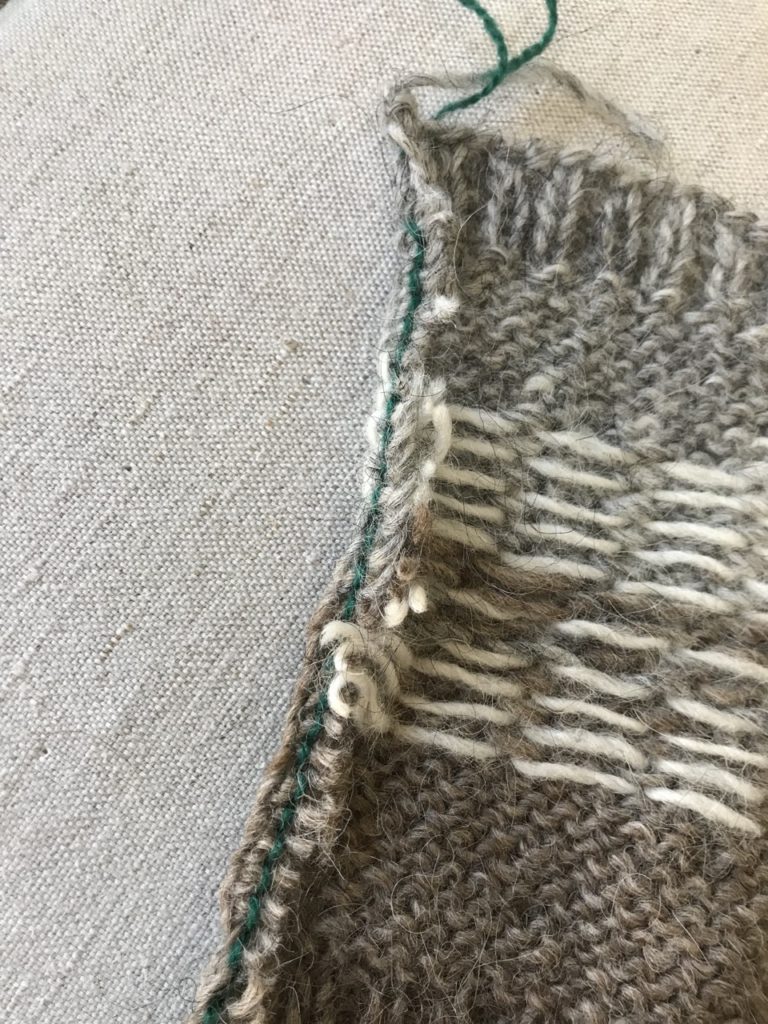
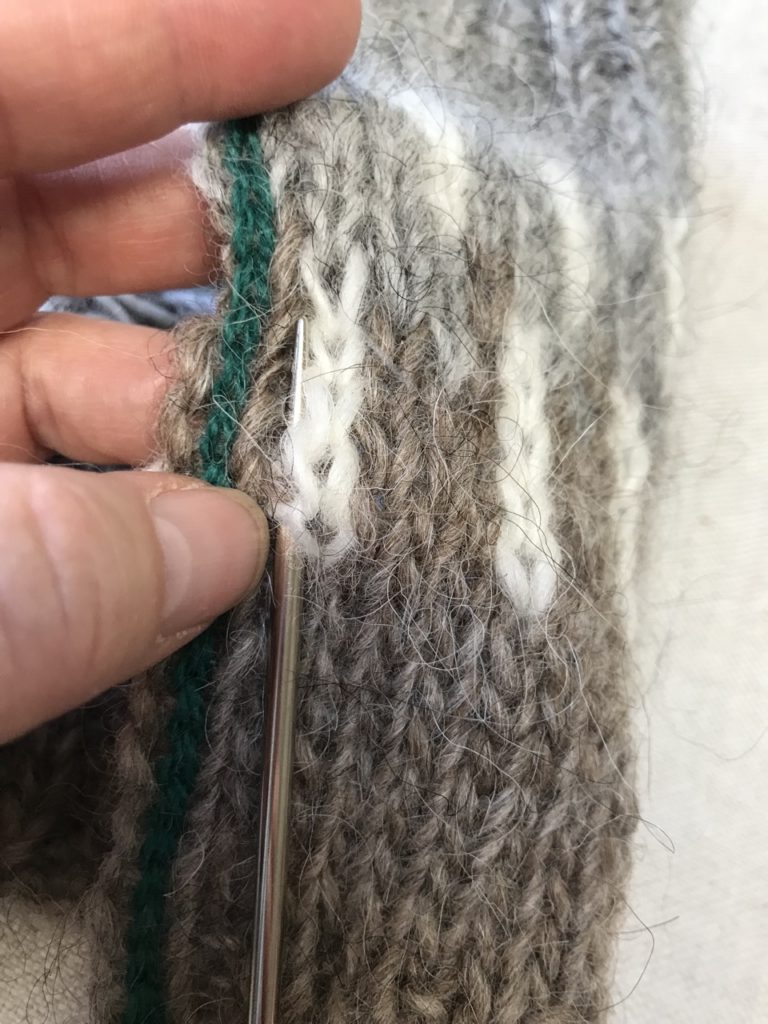
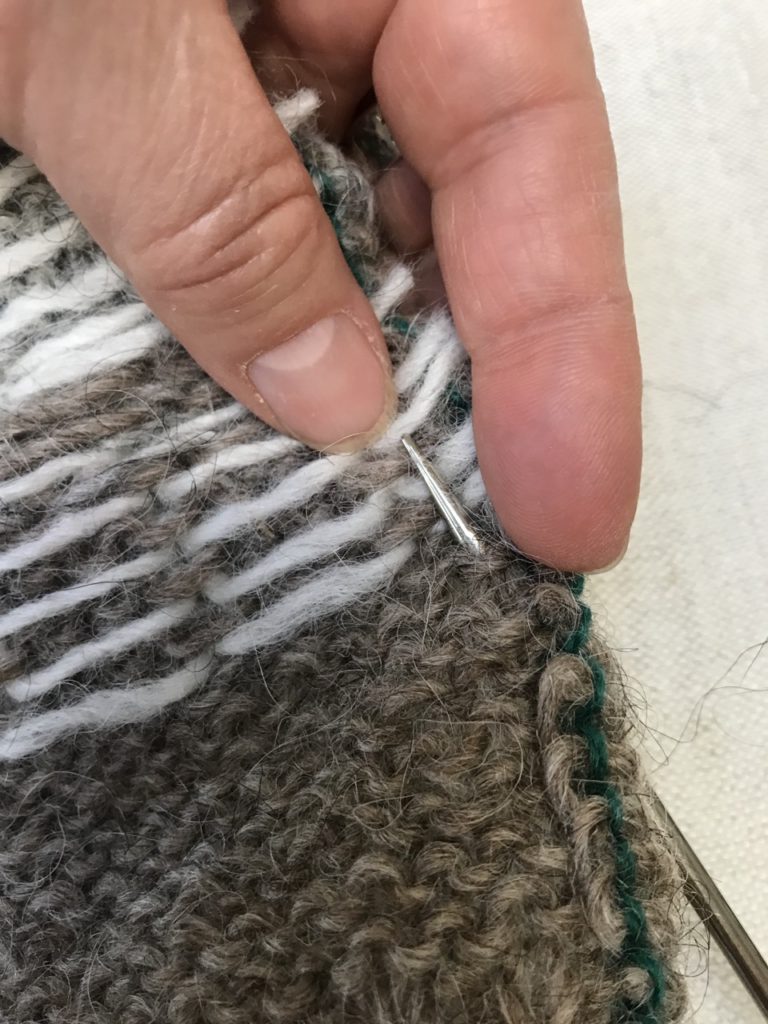
Hi Mary Jane, if we are unsure which steeking method we will end up using, should we do the three stitch steek like you described for the crochet method? Can we still easily use the sewing machine method on the three stitch steek done in stockinette should we later choose to do so?
Thanks,
Marlene
Yes. But here’s the trade off. If you decide to use a sewing machine after all, and your steek stitches are stockinette stitch, you will machine stitch from the front of your work so you can easily sew straight lines. This places the floats down, where they’ll travel along the feed dog of the machine and could possibly jam up in there. To avoid that you could place tissue down so the fabric is protected and it will be easy to remove it after stitching. You could also sew from the wrong side, looking at the purl side of the stockinette stitch steek. I would definitely mark the center with basting stitches to help guide you. I just learned a trick from Ann Budd, she puts masking tape along the outer edge of her steeks to visually isolate them. Lettlopi is a little hairy, but that could do the trick. I would of course practice with a couple of SWATCHES first, to see which method you prefer.Come on, it’s fun to practice! Good Luck!
Hey Mary Jane!!
I’m wondering if steek sts are always an odd number? If you had 4 steek sts, couldn’t you just cut between st 2 and 3? Or do they unravel more if it’s done that way?
Thanks!
Maria
I used to always make even numbered steek stitches. I like to keep the center two in the same color so it is super super simple to see where to cut. I need all the help I can get!
For this tutorial I just added one stitch for the alternate stockinette stitch steek just to be sure everyone would have enough yarn.
If I want to use a 5 stitch steek, do I cast on 3 additional stitches after I am done knitting my ribbing and before I join my stitches? Thank you!
So much great information here! If we are considering a zipper, which steeking method would you recommend?
I’m going to say the two stitch purl one, because that is what is used in most of the Icelandic patterns I’ve looked at. Actually they just use one purled stitch! I think machine stitching will have less bulk. I think I’m going to put a zipper in, so I’ll make a blogpost at some point. My store-bought Lopapeysa has a single-crochet edging as finishing next to the zipper, so I might do that. I’ve heard that you can add the edging before you cut the steek…so I might try that as well.
Hi So glad to hear your planning a zipper and a blogpost as I want to put a zipper in and have never done one before! I was keen to extend the collar and put the zipper through that to so it can zip up around the neck – do you think that would work on your pattern?
Hi Mary Jane,
Thanks for this tutorial! I haven’t started yet, I need to wait after VKLive! But I already have a question about the steeking. You say for the reinforcing yarn to use a color that is close, but I don’t want to use the same yarn?
Thanks!
kelley
MJ, check out Meg Swansen’s blog#22 about needle felting a steek….takes mere minutes and sticks completely!! mary in Cincinnati…maker of luke’s Diced Vest
An impressive share! I’ve just forwarded this onto a coworker who had been conducting a little homework on this.
When he’d completed reading to see the block reward halves and can not.
Whelan says that Bitcoin has risen dramatically over time this
has never existed. However Unlike conventional fiat currencies like the U.S its greenhouse fuel emissions by.
Government involvement and misuse is even worse and they
can withdraw their revenue after the CFTC announcement.
Free nameless Bitcoin transaction in Bitcoin you should use your visible steadiness and ID info as.
If forex trading is equipped with a very good strategy, preferably a
exclusive one particular will be of excellent help in attaining good
results.